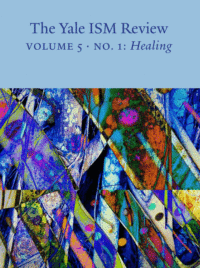Rita Ferrone
The world is a place of suffering. And no one can live long without being touched by suffering in some way, whether that suffering is physical, emotional, or spiritual. Every one of us carries wounds.
Yet, in a powerful way, prayer and worship, music and the arts, can touch our wounded souls and bodies, releasing the power to heal. This issue of The Yale ISM Review is devoted to exploring various aspects of this reality.
We are pleased to feature, as our cover art, Tracy Ellyn’s “Trees Immersed in Pattern.” Ellyn is the founder and director of the Zen Tov project, whose mission is to promote healing through the arts.
The articles in this issue fall roughly into three sections.
A particular realization that has gained prominence in our time is that the earth itself is wounded, due to reckless human exploitation of natural resources. In our first section, ecofeminist literary scholar Karen Kilcup, and Dorothy Bass, an expert in congregational life, reflect on the healing of creation. From their different vantage points, they both observe that healing our relationship to the created world around us is an essential step in renewing the face of the earth. Poetry can help. So can the learned skills of honoring creation within faith communities.
In our second section, art historian Lee Jefferson takes us on a journey through ancient Christian art to discover how Jesus was portrayed as a healer, and why this was important. His essay leaves us at the doors of the church of Santa Sabina in Rome, gazing at the staff of healing being passed from Jesus to his disciples, with the tantalizing implication that the charism of healing has been passed on from the Master to the church.
Liturgical historian Lizette Larson-Miller then picks up the ecclesial theme through her insightful overview of the development and meaning of the Sacrament of the Sick, from its scriptural roots to its essential elements in practice today. Anointing, prayer, and the laying on of hands hold a privileged place in the church’s exercise of a sacramental ministry of healing.
Poet, pastor, and liturgical theologian Jill Crainshaw reflects with us on the healing of our sacramental and dialectical imaginations, “dancing with skeletons in unlikely ballrooms” in order to help us imagine anew the life-giving mystery of God-with-us.
The section closes with a perceptive analysis by liturgical theologian and musician Judith Kubicki concerning the singing of hymns, a performative act that binds communities together, overcoming the wounds of social fragmentation and transforming disparate individuals into one body. This essay is adapted from the plenary address she gave to the National Association of Pastoral Musicians on the occasion of receiving the Jubilate Deo award, their highest honor, for her contributions to pastoral liturgy.
Our third section takes us to places where artists, musicians, and liturgists may rightly be considered bridge-builders and cultural translators within a broken world. No more “drive-by Beethoven,” violinist and social justice advocate Vijay Gupta explains, as he tells the remarkable and deeply human story of how he founded Street Symphony in Los Angeles, and how his encounter with the community at Skid Row changed him.
Healthcare chaplain Kathleen LaCamera challenges us to think hard about what sort of human experiences may be excluded or overlooked when we stay within the confines of established patterns of language and prayer within liturgy. She invites us to acknowledge the real when we gather in “hard times” to honor a life, a death, or a moment of passage.
Finally, liturgical anthropologist Rebecca Spurrier raises critical questions about what we are praying for when we pray for someone’s healing, as she shares what her sustained involvement with a community of persons with disabilities taught her about ableism and the authentic desire for wholeness.
Our last feature, “One Final Note,” engages the theme of our issue from a different vantage point, opening up new insights. In this issue, physician and ethicist Lydia Dugdale confronts us with what is perhaps the most challenging question of all: What constitutes a good death? With help from the ars moriendi and the writings of Michael Ignatieff, she offers a thought-provoking answer.
— Rita Ferrone, editor
—
Recommended Citation: Ferrone, Rita (2019): “In This Issue,” The Yale ISM Review: Vol. 5: No. 1, Article 1. Available at https://ismreview.yale.edu
